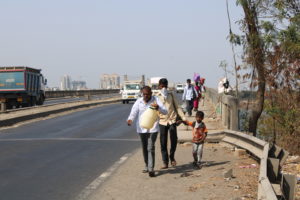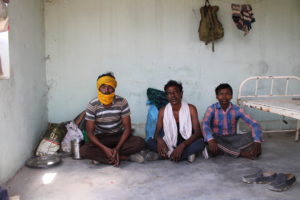No country for migrant workers

Sightings of groups of migrant workers are fairly common along the Indian highways nowadays (MIG photos/ Varsha Singh)
The fate of millions of migrant workers across India has been hanging in the balance ever since the lockdown following the coronavirus outbreak was announced 35 days ago.
The Mumbai-Nashik Expressway is one of the busiest arterial roads of India, with thousands of trucks carrying varied loads criss crossing it every day. However, ever since the lockdown was announced on March 25, another kind of traffic has been very visible on this national highway –the traffic of thousands of people, carrying heavy loads on their heads or in backpacks, braving the blazing sun and walking on a road that was not constructed for pedestrians. It was on this road last Tuesday that your correspondent came across a couple with their two small children walking across a bridge barely a few km from Thane, the largest suburb of Mumbai. Nitesh and Kanta had only recently moved to Mumbai from Amravati, a district of Maharashtra, to make some money while their farm lay idle up to the sowing season that begins in September once the monsoons are over. Little did they know that their idea of moving to Mumbai for work would backfire as they would have to sit idle just like their farms for a much longer period.
“We waited for a month thinking that the government will lift the lockdown but it doesn’t seem so. The cases are rising everyday and we couldn’t wait any longer. We have no money. I was a daily wager and now I have nothing left with me. So I have decided to walk from Mumbai to Amaravati, on foot, just to be in our village where at least we can fend for ourselves,” say Nitesh and Kanta who used to live in Kandivali, a north western suburb of Mumbai.
On Tuesday, your correspondent could see dozens of groups of migrant workers walking along the Mumbai-Nashik Expressway right up to Igatpuri, over 120 km from Mumbai. If this was the flow of migrants on day 35 of the lockdown on just one of the routes exiting Mumbai, then the total number of migrant workers caught in a perilous situation and on the move from their adopted homes to their villages is anybody’s guess as neither the government nor any civil society group has been able to quantify the scale of the problem so far.
In a country where collecting real-time data on numerous issues has become increasingly challenging, the entire issue of migrant workers is one where hard data on their situation even before the lockdown and Covid19 was hard to come by as not only were the workers highly mobile, moving from one construction site to another, often in different cities and even states, but also most of them lacked any official documentation such as an identity card. Even estimating the total number of migrant workers in India is largely guesswork. While the Census of India reports that in 2011, there were 450 million internal migrants in India, up from 309 million in 2001, the World Bank recently put the number at a ridiculously low 40 million. Whether the total number of migrants is 450 million or 600 million or indeed even 40 million, an overwhelming number of them find temporary jobs or work as daily wage worker who gets paid each day at the end of the day.
With little or no savings, limited access to any social security net and dependent only upon their capacity to work, if they find any, the migrant workers are amongst the most marginalised sections of the Indian society. Indeed, though most of them belong to villages where they often have some land holdings, the size of these holdings and the extremely low productivity pushes them to look for work outside their villages. They are attracted to the cities by the possibilities of getting wages that can be twice or thrice what they could make in their villages through farming.
This was the case with Lalban, 46, and Baisakhu, 48, hailing from Umaria district on the eastern fringes of Madhya Pradesh, a state in central India. They both left their village to work in Pune. However, barely a few weeks after they had begun working on a road project in the city, the lockdown was announced and it brought the road construction, like practically every other activity in the country, to a complete halt.

(L-R) Lalban, Baisakhu and Narottam were fortunate to find shelter at a Snehalaya centre in Ahmednagar on their 1200 km trek from Pune to Umaria
“When the work came to a halt, we asked our employer what was to be done. He asked us to wait for a few weeks as the lockdown was meant to be only for three weeks. However, it got extended and we waited in the rented room in Pune for over a month. But by then all our earnings from Pune had gotten over and we were left with no choice but to hit the road and try to walk back to our village, even though it is over 1200 km from Pune,’’ they say.
“We joined a group of 25-30 persons who were also headed towards Madhya Pradesh and we began walking. We came across some policemen who advised us to walk along the railway tracks, so that we could reach Itarsi (a major railway station about 800 km from Pune) and from there we could perhaps find some space on a freight train to go towards Umaria. So we began walking. We didn’t have much money, but were lucky enough to find people in villages on the way who were kind enough to give us food and some rations to carry with us on our journey,” they say.
However, after a few days when they reached Ahmednagar, some villagers told them of Snehalaya, one of the biggest and most respected NGOs of the city, that works primarily with HIV positive female sex workers and their children. Lalban, Baisakhu and Narottam, their 22-year-old companion on the journey, have been offered accommodation and food for a few days by Snehalaya at one of its centres in Ahmednagar, while they decide the future course of action.
“We have asked the villagers to tell the migrants that they come across on the roads about our shelter homes and how they can stay for as long as they need, before they decide their future course of action,” Girish Kulkarni, founder of Snehalaya, tells Media India Group.
The trio could indeed count themselves amongst the luckier ones of the thousands of migrants who have been forced to take the harsh roads that have so far claimed the lives of dozens of migrants on the trek back home. The crisis could indeed have been far worse and claimed many more lives had it not been for good samaritans like Snehalaya, popping up all over the country to help the vulnerable.
The government has so far callously ignored the plight of the migrant workers and indeed turned a blind eye even to their existence. Very belatedly, nearly three weeks after the lockdown was announced, it began setting up some shelters for the migrant workers, but the reach of these shelters was rather limited as millions of people like Lalban and Baisakhu could have indeed avoided the trek. It is only now, seven weeks into the lockdown has the government begun to recognise that indeed the hundreds of millions of migrant workers could be facing life and death questions due to lack of work.
Now, the government has very generously ‘allowed’ the workers to go back home even if it involves interstate travel. But it has attached another rider to its gesture that could indeed render the entire exercise fruitless as the centre government has asked state governments to organise transport for their respective share of migrant populations trying to return home. By the time the government machinery gets into motion, indeed the blazing sun and the treacherous roads would have claimed scores more of migrant workers on their dangerous trek home.









